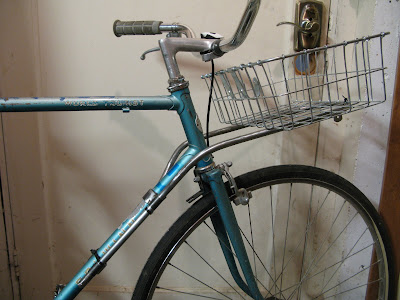



I've been wanting to try out this design for at least 2 years. I finally bought a tube bender and some over priced tube and went to Ben's house in Corvallis. Ben has a small machine shop stuffed in his basement (I meant to take a picture of it) that has everything we needed: mill, lathe, bits of junk metal, etc. It took about three days to make the prototype but only about 18-20hrs total. There were various family commitments that kept Ben busy, in between obligations we would drink beer, bend, weld, machine and look for the right size bits of metal in the shop and around Corvallis. We had to machine the bits of tube that are used for the mount since one has to be the right size to fit snugly on the bike frame and the other has to be the right size to take the arms of the rack with out too much slop. They were all made from bar stock.
The idea for building this rack came from my dissatisfaction with most front bike racks that are mounted off the front fork or handle bars or both. When the rack is connected to the front wheel assembly it flops when it has any weight in it. It makes the steering sluggish and wobbly depending on how rigid the rack is. When bikes were more commonly used for carrying heavy loads there were all sorts of frame mounted racks. Butcher bikes are the type most closely related to what I'm trying to achieve with this prototype. Butcher bikes are purpose built often have a tall steering tube and a shorter front fork with smaller front wheel. This set up keeps the handle bars from hitting whatever is in the rack, since the rack does not move with the handle bars, it also keeps the center of gravity lower by having a smaller front wheel. My front rack design is for lighter duty (around 20lbs). This rack can be easily mounted to the frame and then taken back off when not needed. There is a guy in Holland who makes a similar one but his is much larger, heavier and meant for bigger loads. Its also really expensive since its made in a place where people recieve a living wage. The shipping is also expensive due to the size and weight.
This is the first prototype. Since it is not clamped to the frame with a hose clamp style clamp and has no welded cross bracing it twists a little and seems to shift off center too easily. I wanted to try and make the whole rack out of one piece of bent tube but its turning out to be a real pain in the ass. This is due to the dies used to bend the tube. Tube can only bend in a certain radius according to size of tube and tube wall thickness or gauge. The radius of the bend requires the die to be the same size. Die size limits the proximity of bends to each other (about 3" in the case of this 1/2" tube. I'm using a 3" radius die. There is also a 2 1/4" die that I don't own yet. I don't think a smaller die will solve my problem. The tube can be cut up after bending then pinned and rewelded so the bends can be as close as one wants but thats a pain in the ass requiring lots of jigs and grinding/polishing. The prototype was made in this "cut up and piece back together" fashion. Its okay but I think I will just make a 44 degree bend in two pieces of 2' long 1/2"tube and then weld two cross tubes on top of those it will end up looking like a tic tac toe grid with two longer bent legs. This might work as far as keeping out of the way of the break cable as well. Ben thinks I should make the cross bracing a sort of rectangle or rectangle with rounded corners, maybe two 180 degree bends welded together. This would make it more rigid and safer since there wouldn't be any tube sticking out like spears.







